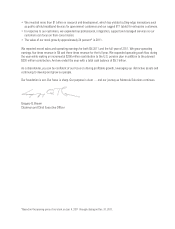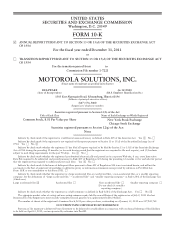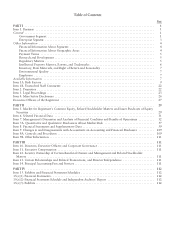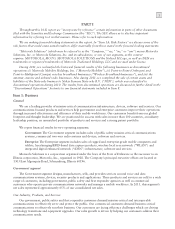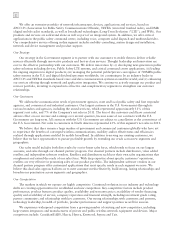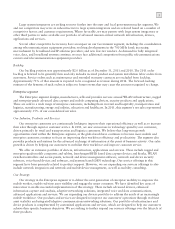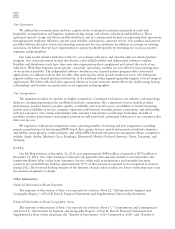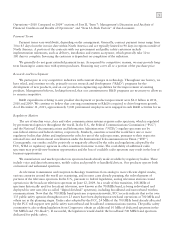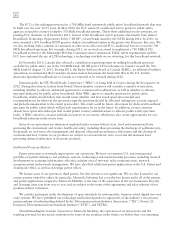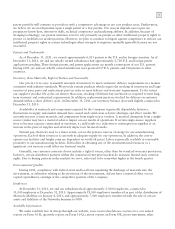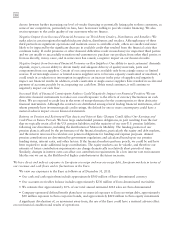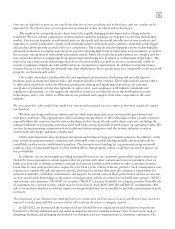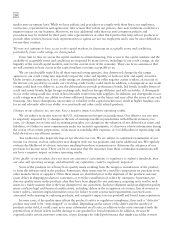Motorola 2011 Annual Report Download - page 12
Download and view the complete annual report
Please find page 12 of the 2011 Motorola annual report below. You can navigate through the pages in the report by either clicking on the pages listed below, or by using the keyword search tool below to find specific information within the annual report.
6
The FCC is also making provisions for a 700 MHz band nationwide public safety broadband network that may
be built over the next 10-15 years. In May 2010, the FCC issued 21 conditional waiver grants to public safety
agencies around the country to deploy 700 MHz broadband systems. Thirty-three additional waiver petitions are
pending FCC decisions as of December 2011. Several of the broadband waiver grantees also benefit from federal
Broadband Technology Opportunity Policy (“BTOP”) Grant Funds issued by the NTIA during 2010. In 2010, we
were awarded a $50.6 million BTOP grant to deploy a broadband system in the greater San Francisco Bay area. We
are also working with a number of customers in other areas who received FCC conditional waivers to use the 700
MHz broadband spectrum. For example, during 2011, we received an award to implement a 700 MHz (LTE)
broadband system for the Mississippi Wireless Communication Commission. Public safety organizations and the
FCC have endorsed the use of LTE technology, a technology in which we are investing, for this broadband network.
In November 2010, Canada also released a consultation requesting input on making broadband spectrum
available for public safety use in the 700 MHz band. All full power TV broadcasters in Canada vacated the 700
MHz band by August 31, 2011. During 2011, the Radio Advisory Board of Canada (RABC), an influential industry
association, recommended that Canadian decision-makers harmonize the band with that in the U.S. Further
decisions regarding broadband use in Canada are expected to be released during 2012.
Internationally, the ITU World Radio Conference (“WRC”) is being held in Geneva during the first quarter of
2012. During this session, leaders from United Nation member countries will consider a number of initiatives,
including whether to allocate additional spectrum for commercial broadband use as well as whether to allocate
spectrum dedicated for public safety broadband. If the WRC agrees to consider spectrum for public safety
broadband, studies would follow that would assess whether and how much spectrum is needed and
recommendations for where in the spectrum range the spectrum should be allocated (taking into account regional
and global harmonization to the extent practicable). The result could be future allocations for dedicated broadband
spectrum for public safety which will provide opportunities for us in the future. In addition, certain countries
already have spectrum landscapes that would permit country administrations to allocate public safety spectrum
today. A WRC initiative can spur individual countries to act sooner, which may also create opportunities for our
broadband solutions in the nearer term.
Some of our operations use substances regulated under various federal, state, local and international laws
governing the environment and worker health and safety, including those governing the discharge of pollutants into
the ground, air and water, the management and disposal of hazardous substances and wastes and the cleanup of
contaminated sites. Certain of our products are subject to various federal, state, local and international laws
governing chemical substances in electronic products.
Intellectual Property Matters
Patent protection is extremely important to our operations. We have an extensive U.S. and international
portfolio of patents relating to our products, systems, technologies and manufacturing processes, including research
developments in scanning, information collection, mission-critical two-way radio communication, network
communications and network management. We have also filed additional patent applications in the U.S. Patent and
Trademark Office, as well as in foreign patent offices.
We license some of our patents to third parties, but this revenue is not significant. We are also licensed to use
certain patents owned by others. In particular, Motorola Solutions has a royalty free license under all of the patents
and patent applications assigned to Motorola Mobility at the time of the separation of the two businesses. Royalty
and licensing costs vary from year to year and are subject to the terms of the agreements and sales volumes of our
products subject to licenses.
We actively participate in the development of open standards for interoperable, mission-critical digital two-way
radio systems. We have published our technology and licensed patents to signatories of the industry’s two primary
memorandums of understanding defined by the Telecommunications Industry Association (“TIA”), Project 25,
European Telecommunications Standards Institute (“ETSI”), and TETRA.
Notwithstanding the transfer of patents to Motorola Mobility, the expiration of certain patents and the
resulting potential for increased competition for some of our products in the future, we believe that our remaining




